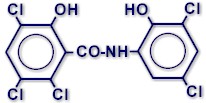Oxyclozanide is an antiparasitic active ingredient used in veterinary medicine against internal parasites (mainly flukes) of livestock. It is not used against agricultural and household pests. It belongs to the chemical class of the salicylanilides.
Common name: OXYCLOZANIDE
Type: veterinary medecine
Chemical class: salicylanilide
CHEMICAL STRUCTURE

EFFICACY AGAINST PARASITES
Type of action: Mainly flukicide anthelmintic, endoparasiticide
Main veterinary parasites controlled: various flukes
Efficacy against a specific parasite depends on the delivery form and on the dose administered.
Click here for general information on features and characteristics of PARASITICIDES.
DOSING
Oxyclozanide is a narrow-spectrum anthelmintic effective against a few fluke species. It is ineffectice against roundworms, tapeworms or external parasites. It is used scarcely in ruminants (mainly in drenches) but not in other livestock, horses or pets.
The table below indicates some usual dosing recommendations for oxyclozanide issued by manufacturers or documented in the scientific literature. They may not be approved in some countries.
| Dosing recommendations for OXYCLOZANIDE |
||
| CATTLE | ||
| Delivery | Parasites | Dose (against oxyclozanide-susceptible parasites) |
| Oral | Fasciola hepatica, adults | 10-15 mg/kg |
| Oral | Paramphistomum spp | 15 mg/kg |
| Oral | Moniezia spp (gravid segments) |
10 mg/kg |
| SHEEP | ||
| Delivery | Parasites | Dose (against oxyclozanide-susceptible parasites) |
| Oral | Fasciola hepatica, adults | 10-15 mg/kg |
| Oral | Paramphistomum spp | 15 mg/kg |
DISCLAIMER: Liability is denied for any possible damage or harm to persons, animals or any other goods that could follow the transmission or use of the information, data or recommendations in this site by any site visitor or third parties.
Dosing recommendations for antiparasitics depend on national regulations. National regulatory authorities determine whether a product is approved for a given indication, i.e. use on a particular host at a specific dose and against a specific parasite. Check the labels of the products available in your country for specific information on approved indications.
SAFETY
Oral LD50, rat, acute*: 3519 mg/kg
Dermal LD50, rat, acute*: not found
* These values refer to the active ingredient. Toxicity has to be determined for each formulation as well. Formulations are usually significantly less toxic than the active ingredients.
MRL (maximum residue limit) established for either beef, mutton pork or chicken meat*:
- CODEX: No
- EU: Yes
- USA: No
- AUS: Yes
* This information is an indicator of the acceptance of an active ingredient by the most influential regulatory bodies for use on livestock.
Withholding periods for meat, milk, eggs, etc. depend on delivery form, dose and national regulations. Check the product label in your country.
Learn more about oxyclozanide safety (poisoning, intoxication, overdose, antidote, symptoms, etc.).
General safety information for antiparasitics is available in specific articles in this site (click to visit):
- General safety of antiparasitics for domestic animals
- General safety of antiparasitics for humans
- General safety of antiparasitics for the environment
|
WARNING It is obvious that veterinary products are not intended for and should never be used on humans!!! |
MARKETING & USAGE
Decade of introduction: 1960
Introduced by: ICI
Some original brands: ZANIL
Patent: Expired (particular formulations may be still patent-protected)
Use in LIVESTOCK: Yes, rather scarce
Use in HORSES: NO
Use in DOGS and CATS: No
Main delivery forms:
Use in human medicine: No
Use in public/domestic hygiene: No
Use in agriculture: Yes, as a mulluscicide
Generics available: Yes, very few
PARASITE RESISTANCE
In livestock: No. It seems that there is no cross-resistance with other salicylanilides
Visit also the section in this site about parasite resistance to antiparasitics and more specifically to salicylanilides.
SPECIFIC FEATURES
Oxyclozanide is a veteran narrow-spectrum flukicide scarcely used in livestock, almost only in ruminants. It is available in the form of drenches, often mixed with a broad-spectrum nematicide.
It is not used in cats and dogs.
Efficacy of oxyclozanide
Oxyclozanide is effective against adult liver flukes (Fasciola hepatica) as well as against immature stages in the tissues (older than 10 weeks). Efficacy against rumen flukes (Paramphistomum spp) is limited. It has also a dose-dependent effect on larvae of cattle grubs (Hypoderma spp) and sheep nasal bot flies (Oestrus ovis). It has no efficacy whatsoever against roundworms and heads or not-gravid segments of tapeworms.
As most other salicylanilides oxyclozanide has a certain residual effect, i.e. it not only kills the parasites present in the host at the time of treatment, but also protects against re-infestation for a period of time (up to several weeks) that depends on the dose and the specific parasite.
Pharmacokinetics of oxyclozanide
After oral administration oxyclozanide is slowly absorbed into the bloodstream. Maximum blood concentrations in sheep and cattle are reached about 24 hours after treatment. Oxyclozanide binds strongly and almost completely (>99%) to plasma proteins.
Oxyclozanide is excreted mainly through bile and feces (up to 80%) the rest in urine and <0.1% in milk, mostly as unchanged oxyclozanide. Excretion half-life in sheep is about 7 days. Oxyclozanide excretion in milk of lactating cows is rather low, and several oxyclozanide products are approved for use on dairy animals.
Mechanism of action of oxyclozanide
The molecular mode of action of salicylanilide, including oxyclozanide, is not completely elucidated. They all are uncouplers of the oxidative phosphorylation in the cell mitochondria, which disturbs the production of ATP, the cellular "fuel". This seems to occur through suppression of the activity of succinate dehydrogenase and fumarate reductase, two enzymes involved in this process. This impairs the parasites motility and probably other processes as well.
Click here to view the list of all technical summaries of antiparasitic active ingredients in this site.